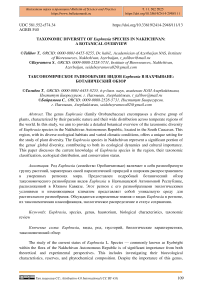Taxonomic diversity of Euphrasia species in Nakhchivan: a botanical overview
Автор: Talibov T., Bayramova S.
Журнал: Бюллетень науки и практики @bulletennauki
Рубрика: Естественные науки
Статья в выпуске: 2 т.11, 2025 года.
Бесплатный доступ
The genus Euphrasia (family Orobanchaceae) encompasses a diverse group of plants, characterized by their parasitic nature and their wide distribution across temperate regions of the world. In this study, we aim to provide a detailed botanical overview of the taxonomic diversity of Euphrasia species in the Nakhchivan Autonomous Republic, located in the South Caucasus. This region, with its diverse ecological habitats and varied climatic conditions, offers a unique setting for the study of plant diversity. The Euphrasia species in Nakhchivan represent a significant portion of the genus' global diversity, contributing to both its ecological dynamics and cultural importance. This paper discusses the current knowledge of Euphrasia species in the region, their taxonomic classification, ecological distribution, and conservation status.
Euphrasia, species, genus, haustorium, biological characteristics, taxonomic review
Короткий адрес: https://sciup.org/14131800
IDR: 14131800 | УДК: 581.552+574.34 | DOI: 10.33619/2414-2948/111/13
Текст научной статьи Taxonomic diversity of Euphrasia species in Nakhchivan: a botanical overview
Бюллетень науки и практики / Bulletin of Science and Practice
UDC 581.552+574.34
The study of the current status of Euphrasia L. Species — commonly known as Eyebright within the flora of the Nakhchivan Autonomous Republic is of significant importance from both theoretical and experimental perspectives. This includes investigating their bioecological characteristics, reserves, and phytochemical composition. Despite the importance of this genus, detailed studies on Euphrasia L. remain limited. Recognizing this gap in knowledge, we have initiated a study to explore the Euphrasia genus in the Nakhchivan Autonomous Republic.
The Euphrasia genus, formerly classified under the Scrophulariaceae Juss. family, has recently been reclassified into the Orobanchaceae Vent. family, according to recent taxonomic revisions [8, 9].
This genus consists of hemiparasitic plants, with approximately 450 species distributed across the non-tropical regions of the Northern Hemisphere, particularly in the mountainous areas of East and Central Asia. In Azerbaijan, especially in its mountainous regions, ranging from the middle mountain belt to the alpine belt, Euphrasia species thrive on arid slopes and in forests, predominantly in subalpine and alpine meadows. A total of 15 species have been documented in Azerbaijan, with 7 species recorded within the Nakhchivan Autonomous Republic itself [2].
The plants of the Euphrasia genus are primarily annual herbaceous species that typically grow to a height of 5-50 cm. They possess a poorly developed, often fringed root system. Morphologically, Euphrasia species are characterized by erect, short, non-fleshy, and branching stems. Their flowers are irregular in shape, arranged singly in the axils, or in apical spike-shaped or racemose clusters. These flowers are typically white, blue, or lilac with yellowish spots and dark purple streaks. The calyx is wedge-shaped or tubular with a small protrusion at the apex. Pollination occurs mainly through insect activity. The high polymorphism observed in Euphrasia species, along with the extensive hybridization processes, complicates their identification and results in the emergence of numerous intermediate forms. Key distinguishing features include the stage of maturity, the shape of the bracts at the top of the plant, and the size of the corolla.
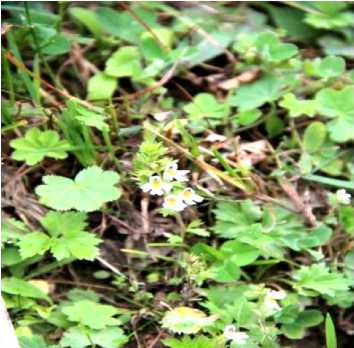
Figure 1. Euphrasia petiolaris
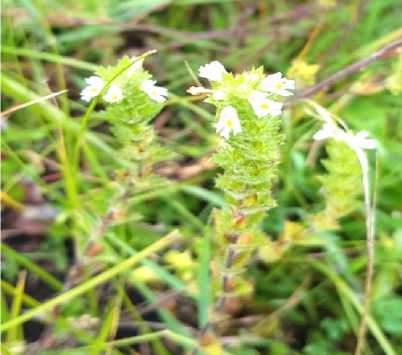
Figure 2. Euphrasia pectinata
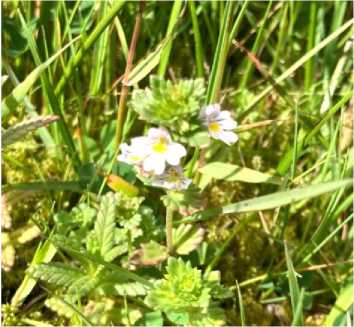
Figure 3. Euphrasia stricta
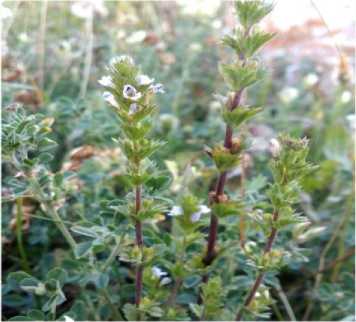
Figure 4. Euphrasia caucasica
This study aims to address the gaps in knowledge surrounding the Euphrasia genus by providing a comprehensive examination of the species in the Nakhchivan Autonomous Republic, contributing to a broader understanding of their ecological roles, biodiversity, and potential for future scientific research.
Materials and Methods
This study was conducted in various regions of Nakhchivan, focusing on mountainous areas from the middle mountain belt to the alpine belt. The species were examined during their flowering period to assess morphological characteristics such as stem height, leaf shape, flower size, and the structure of the peduncle. Species identification was made based on these features, and ecological data was recorded to understand their habitat preferences.
The taxonomic status and distribution of the genus Euphrasia L. in the Nakhchivan Autonomous Republic have been investigated through a review of available literature. The genus has been the subject of numerous taxonomic studies, providing detailed information about its species and distribution. Below is an overview of the taxonomic research conducted on Euphrasia and its species within the region. The following key works contribute to the understanding of the genus: Flora of the USSR: This work details 62 species of Euphrasia , providing a foundational reference for species found across the Soviet Union, including those in the Caucasus and surrounding regions [3].
Flora of the European Part of the USSR: In this book, 27 species of Euphrasia are described, contributing to the understanding of the genus in the European part of the former Soviet Union [4].
Flora of the Caucasus: the Flora Caucasus includes information on more than 100 species of Euphrasia worldwide, with 24 species specifically documented in the Caucasus region. This work is a crucial reference for species found in the southern Caucasus [5].
Flora of Azerbaijan: A key work detailing the distribution of 16 species of Euphrasia within Azerbaijan. Additionally, this source provides information about the genus in Europe, Asia, North and South America, and the Caucasus, with a total of 25 species documented in the Caucasus region [7].
S. K. Cherepanov's Taxonomic Contributions: work offers significant insight into the taxonomic classification of Euphrasia species, contributing to the understanding of the genus’s broader taxonomic status [6].
Various studies conducted by A. M. Askerov, as presented in the books "The Higher Plants of Azerbaijan" and "The Flora of Azerbaijan" , have significantly expanded the existing knowledge of the genus Euphrasia in the region, leading to the identification of 15 species ( E. amblyodonta, E. caucasica, E. daghestanica, E. georgica, E. hirtella, E. juzepczukii, E. karjaginii, E. kurdica, E. nisami, E. ossica, E. pectinata, E. sevanensis, E. Sosnowskyi, E. stricta , E. townsendiana ) of Euphrasia within the flora of Azerbaijan. [1].
Additionally, the taxonomic spectrum of the flora of the Nakhchivan Autonomous Republic has been explored by T. H. Talibov, A. Sh. Ibrahimov, and A. M. Ibrahimov, who documented the species of Euphrasia found in the region in their work, Taxonomic Spectrum of the Flora of the Nakhchivan Autonomous Republic (High-spore, Gymnosperm, and Angiosperm Plants) [2]. According to their study, the following seven species of the genus Euphrasia have been recorded in Nakhchivan (Table).
These species represent a significant portion of the Euphrasia diversity in the Nakhchivan Autonomous Republic. The documentation of these species enriches our understanding of the genus's distribution in this unique and ecologically significant region. The presence of diverse
Euphrasia species across various ecosystems, including subalpine and alpine meadows, arid slopes, and forests, highlights the ecological adaptability and importance of this genus.
Table
SPECİES OF THE GENUS EUPHRASİA L. İN NAKHCHİVAN
|
№ |
Scientific Name |
|
1 |
Euphrasia caucasica Juz. |
|
2 |
Euphrasia georgica Kem.-Nath. |
|
3 |
Euphrasia pectinata Ten. |
|
4 |
Euphrasia tatarica Fich. ex Spreng. |
|
5 |
Euphrasia petiolaris Wettst. |
|
6 |
Euphrasia townsendiana Freyn. ex Wettst. |
|
7 |
Euphrasia stricta D. Wolff ex J. F. Lehm. |
In conclusion, the taxonomic research conducted on the genus Euphrasia in the Nakhchivan Autonomous Republic has provided valuable insights into its diversity and distribution. Future studies focusing on the bioecological characteristics, conservation status, and phytochemical properties of these species will further contribute to the understanding and sustainable management of Euphrasia populations in the region [3].
Results and Discussion
Morphological Diversity. The morphological characteristics of the Euphrasia species found in the Nakhchivan Autonomous Republic exhibit significant variation, which is influenced by both genetic factors and environmental conditions. The stem height and branching patterns are notably variable. For instance, Euphrasia caucasica and Euphrasia georgica , both found in the region, are among the taller species in the genus, reaching heights of up to 40 cm. In contrast, other species, such as Euphrasia pectinata , typically remain shorter, generally not exceeding 20 cm in height. These variations in stem height are linked to the species' ecological niche, where taller species may be better adapted to compete for light in open, exposed environments, while shorter species thrive in denser, more shaded locations.
The leaves of Euphrasia species are another key feature for distinguishing between them. Most species exhibit leaves with sharp teeth along the edges, a characteristic that varies in size, shape, and texture. For example, Euphrasia georgica has bluish-green leaves adorned with 5–7 sharp, long-bladed teeth, which distinguish it from species such as Euphrasia pectinata , whose leaves are smaller and covered with short, stiff hairs. These leaf characteristics are important for species identification and may also contribute to the plant's ability to withstand environmental stress, such as drought or herbivory. The presence of glandular or non-glandular hairs on the leaf surface in some species may also help in water retention or protection from herbivores. (Table 2)
The flowers of Euphrasia species are generally small, typically ranging from 5 to 10 mm in length. These flowers are often sessile or borne on short pedicels. However, there are notable differences in flower morphology among species. For example, Euphrasia caucasica and Euphrasia tatarica produce small, pale-colored flowers, with E. tatarica exhibiting a characteristic pale purple corolla. In contrast, Euphrasia pectinata has a distinct white corolla with yellow spots, which is one of the most distinguishing features of this species. The flower morphology, particularly the shape and color of the corolla, plays a significant role in pollinator attraction, especially for species that rely on insect pollination, such as bees and butterflies. The presence of hairs on the calyx or corolla can also be an adaptive trait for attracting or protecting pollinators.
One of the most intriguing features of Euphrasia species is their semi-parasitic nature. This adaptation allows them to thrive in environments where other plants might struggle. The plants possess haustoria, specialized structures that allow them to extract water and nutrients from host plants, a characteristic typical of the Orobanchaceae family. This semi-parasitism enables Euphrasia species to grow in nutrient-poor soils, such as the rocky and arid slopes typically found in subalpine and alpine meadows. The ability to parasitize other plants gives Euphrasia an ecological advantage in these harsh environments, where nutrient availability can be limited [7].
MAİN MORPHOLOGİCAL CHARACTERİSTİCS OF Euphrasia L. SPECİES
Table 2
|
Species |
Leaf Characteristics |
Flower Characteristics |
Growth Elevation (Altitude Range) |
Habitat |
|
Euphrasia caucasica Juz. |
Ovate leaves with sharp scaly teeth |
Whitish flowers with blue/purple upper lip, dark purple stripes |
Middle to upper mountain zones (1,500 - 2,500 m) |
Meadows, rocky slopes in middle and upper mountain zones |
|
Euphrasia georgica Kem. -Nath. |
Bluish/green, oblong leaves with sharp or blunt teeth |
Small, whitish flowers with blue/purple upper lip, dark stripes |
Middle mountain belts (1,000-2,000 m) |
Dry open slopes in middle mountain belts |
|
Euphrasia pectinata Ten. |
Smooth, green leaves with coarse hairs along edges of teeth |
Pale purple flowers with dark stripes on lips, 710 mm |
Upper mountain zones (1,500-2,500 m) |
Dry slopes, meadows in the upper mountain zones |
|
Euphrasia tatarica Fich. et Spreng. |
Wedge-shaped or ovate leaves with blunt teeth |
Pale lilac flowers, 5-8 mm long |
Steppes and bushes up to middle mountain belt (9001,800 m) |
Steppes and bushy areas |
|
Euphrasia petiolaris Wettst. |
Small, lanceolate to ovate leaves with sharp teeth |
8-15 mm flowers with broad lower lip |
Subalpine and alpine meadows, middle mountain belt (1,200-2,200 m) |
Subalpine and alpine meadows, rocky areas |
|
Euphrasia stricta D. Wolff ex J. F. Lehm. |
Ovate leaves with sharp, prickly teeth |
Pale purple flowers, 6-10 mm long |
Upper mountain belts (1,800-2,500 m) |
Open grassy slopes in upper mountain belts |
|
Euphrasia townsendiana Freyn. ex Wettst. |
Elliptical, oblong leaves with 1-3 sharp or blunt teeth |
Pale purple flowers with dark stripes, 5-7 mm long |
High mountain meadows, rocky steppes (2,0003,000 m) |
High mountain meadows, rocky steppes |
Ecological Adaptations and Habitat Preferences. Ecologically, Euphrasia species predominantly inhabit subalpine and alpine meadows, particularly in regions with rocky slopes, nutrient-poor soils, and high altitudes. These environments are often characterized by harsh growing conditions, including cold temperatures, low soil fertility, and limited moisture availability. The semi-parasitic nature of Euphrasia species enables them to thrive in such conditions by extracting nutrients from host plants, such as grasses and shrubs, which often grow in these meadows. This adaptation is crucial for their survival in environments where resources are scarce.
The distribution of Euphrasia species in the Nakhchivan Autonomous Republic aligns with this ecological preference, as they are found in subalpine and alpine regions, often growing on rocky slopes, along mountain ridges, and in open meadows. These habitats are typically characterized by their exposure to the elements, including high winds and fluctuating temperatures, which can further limit the availability of water and nutrients. The presence of Euphrasia species in these areas indicates their ability to withstand such environmental stresses, thanks in part to their parasitic behavior.
In addition to their ability to survive in nutrient-poor conditions, Euphrasia species also contribute to the biodiversity of the ecosystems in which they grow. By parasitizing other plants, they can influence the composition of plant communities, often reducing the dominance of certain species and thereby promoting greater diversity. This ecological role is particularly important in maintaining the balance of subalpine and alpine ecosystems, where the harsh environmental conditions can lead to the dominance of a few highly competitive plant species.
Conclusion
The genus Euphrasia L. (Eyebright), initially classified within the Scrophulariaceae Juss. family, has recently been reclassified into the Orobanchaceae Vent. family. In Azerbaijan, Euphrasia species are widely distributed across various regions, particularly in mountainous areas, ranging from the mid-mountain zone to the alpine zone, and are commonly found on dry slopes, in forests, and mainly in subalpine and alpine meadows. A total of 15 Euphrasia species have been documented across Azerbaijan, with 7 species recorded specifically in the Nakhchivan Autonomous Republic. The species within this genus are primarily annual, semi-parasitic herbs with a weakly developed fibrous root system and the presence of haustoria. The key diagnostic features for differentiating species are typically observed during maturity, where the shape of the bracts at the top of the plant and the size of the flower corolla are considered significant taxonomic traits.
Список литературы Taxonomic diversity of Euphrasia species in Nakhchivan: a botanical overview
- Аскеров А. М. Флора Азербайджана. Высшие растения - Эмбриофиты. Баку, 2016.
- Талибов Т. Х., Ибрагимов А. С., Ибрагимов А. М. Таксономический спектр флоры Нахичеванской Автономной Республики (Высшие споровые, хвойные и цветковые растения). Нахичевань, 2021.
- Введенский А. И. Род 1352. Очанка - Euphrasia. М.-Л.: Издательство АН СССР, 1955.
- Флора Европейской части СССР. Л.: Наука, 1981. Т. 5. 378 с.
- Гроссгейм А. А. Флора Кавказа (Т. VII). М.-Л.: Издательство АН СССР, 1950.
- Черепанов С. К. Сосудистые растения России и соседних стран (в пределах бывшего СССР). СПб: Мир и Семья-95. 1995.
- Флора Азербайджана. Баку: Издательство АН Азербайджанской ССР, 1957. Т. VII. 646 с.
- Angiosperm Phylogeny Group. An update of the Angiosperm Phylogeny Group classification for the orders and families of flowering plants: APG III // Botanical Journal of the Linnean Society. 2009. V. 161. №2. P. 105-121.
- Худавердиева С. Ф. Фитоценологическое изучение и оценка ценопопуляций некоторых видов Euphorbiaceae, распространенных в Нахичевани // Бюллетень науки и практики. 2022. Т. 8. №12. С. 133-144. https://doi.org/10.33619/2414-2948/85/17.

